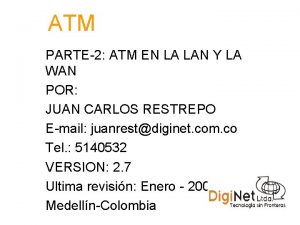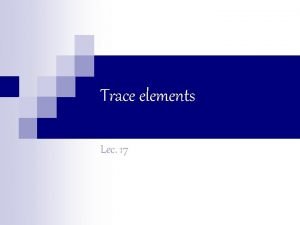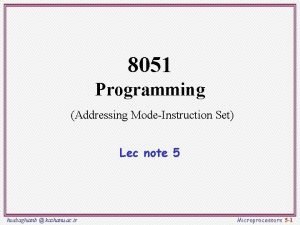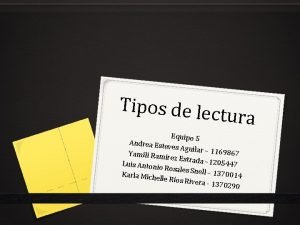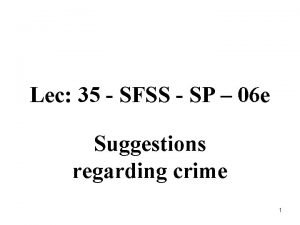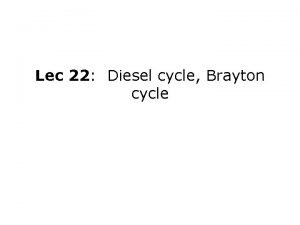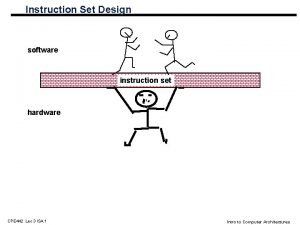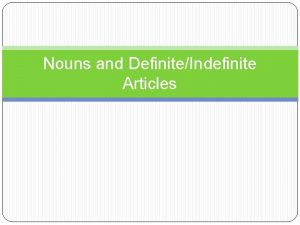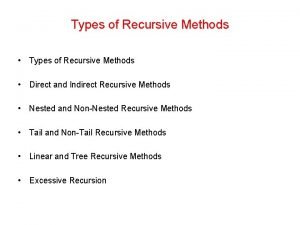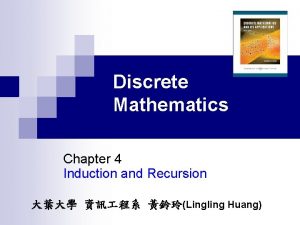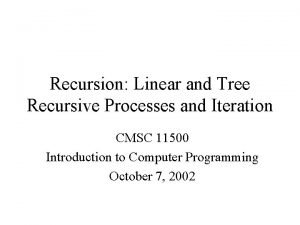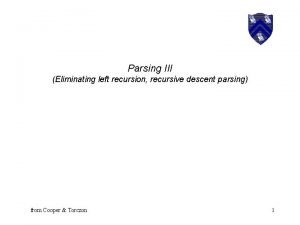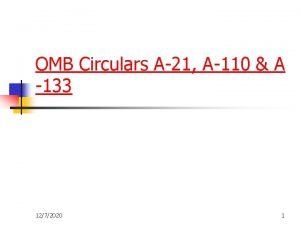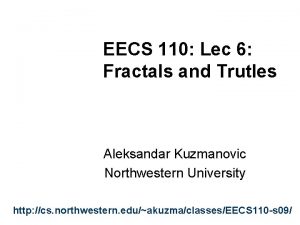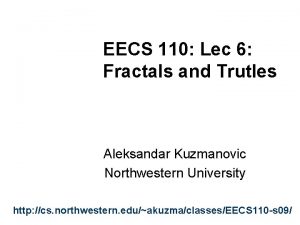EECS 110 Lec 4 Functions and Recursion Aleksandar


























































![mymax( [1, 7, 3, 42, 5] ) Behind the curtain… mymax( [1, 7, 3, 42, 5] ) Behind the curtain…](https://slidetodoc.com/presentation_image_h/2332530d2c88ff837153796f0674287b/image-59.jpg)










![def sajak(s): if len(s) == 0: Base Case return 0 else: if s[0] == def sajak(s): if len(s) == 0: Base Case return 0 else: if s[0] ==](https://slidetodoc.com/presentation_image_h/2332530d2c88ff837153796f0674287b/image-70.jpg)

![def sajak(s): if len(s) == 0: Base Case return 0 else: if s[0] not def sajak(s): if len(s) == 0: Base Case return 0 else: if s[0] not](https://slidetodoc.com/presentation_image_h/2332530d2c88ff837153796f0674287b/image-72.jpg)


- Slides: 74

EECS 110: Lec 4: Functions and Recursion Aleksandar Kuzmanovic Northwestern University http: //cs. northwestern. edu/~akuzma/classes/EECS 110 -s 09/

Functioning in Python # my own function! def dbl( x ): """ returns double its input, x """ return 2*x

Functioning in Python # my own function! def dbl( x ): """ returns double its input, x """ return 2*x keywords Some of Python's baggage… def starts the function return stops it immediately and sends back the return value Comments They begin with # Docstrings They become part of python's built-in help system! With each function be sure to include one that (1) describes overall what the function does, and (2) explains what the inputs mean/are

Functioning in Python def undo(s): """ this "undoes" its string input, s """ return 'de' + s >>> undo('caf'))

Conditional Statements ax**2 + bx + c = 0 If b**2 – 4*a*c is less than 0, then the equation has no solution If b**2 – 4*a*c is equal to 0, then the equation has 1 solution If b**2 – 4*a*c is greater than 0, then the equation has 2 solutions

Striving for simplicity… def qroots(a, b, c): """ qroots(a, b, c) returns a list of the real-number solutions to the quadratic equation ax**2 + bx + c = 0 input a: a number (int or float) input b: a number (int or float) input c: a number (int or float) """ if b**2 - 4*a*c < 0: # If b**2 – 4*a*c is less than 0 # then the equation has no solution return [ ] if b**2 - 4*a*c == 0: return [-b/(2*a)] # If b**2 – 4*a*c is equal to 0 # then the equation has one solution else: # Otherwise, the equation has 2 solutions return [(-b-(b**2 - 4*a*c)**0. 5)/(2*a), (-b+(b**2 4*a*c)**0. 5)/(2*a)]

Naming data == Saving time def qroots(a, b, c): """ qroots(a, b, c) returns a lost of the real-number solutions to the quadratic equation ax**2 + bx + c = 0 input a: a number (int or float) input b: a number (int or float) input c: a number (int or float) """ d = b**2 - 4*a*c if d < 0: return [ ] if d == 0: return [ -b/(2*a) ] r 1 = (-b + d**0. 5)/(2*a) r 2 = (-b - d**0. 5)/(2*a) if r 1 > r 2: return [ r 2, r 1 ] else: return [ r 1, r 2 ] Simpler to fix, if needed! Faster to run, as well…

Naming data == Saving time def qroots(a, b, c): """ qroots(a, b, c) returns a lost of the real-number solutions to the quadratic equation ax**2 + bx + c = 0 input a: a number (int or float) input b: a number (int or float) input c: a number (int or float) """ d = b**2 - 4*a*c Name once - use often! if d < 0: return [ ] if d == 0: return [ -b/(2*a) ] r 1 = (-b + d**0. 5)/(2*a) r 2 = (-b - d**0. 5)/(2*a) if r 1 > r 2: return [ r 2, r 1 ] else: return [ r 1, r 2 ] Simpler to fix, if needed! Faster to run, as well…

Functioning Python… # data gets named on the way IN to a function defs must be at the very left def qroots(a, b, c): """ qroots(a, b, c) returns a lost of roots to the quadratic equation ax**2 + bx + c = 0 input a: a number (int or float) Docstrings input b: a number (int or float) become part of input c: a number (int or float) """ python's help Indenting d = b**2 - 4*a*c system if d < 0: indicates return [ ] code "blocks" qroots "block" is 11 lines if d == 0: return [ -b/(2*a) ] r 1 = (-b + d**0. 5)/(2*a) r 2 = (-b - d**0. 5)/(2*a) if r 1 > r 2: return [ r 2, r 1 ] else: return [ r 1, r 2 ] # notice that we don't get to name data on the way out…

How functions work… def demo(x): return x + f(x) def f(x): return 11*g(x) + g(x/2) def g(x): return -1 * x What is demo(-4) ?

How functions work… def demo(x): return x + f(x) def f(x): return 11*g(x) + g(x/2) def g(x): return -1 * x What is demo(-4) ? demo x = -4 return -4 + f(-4)

How functions work… def demo(x): return x + f(x) def f(x): return 11*g(x) + g(x/2) demo x = -4 return -4 + f(-4) f def g(x): return -1 * x What is demo(-4) ? x = -4 return 11*g(x) + g(x/2)

How functions work… def demo(x): return x + f(x) def f(x): return 11*g(x) + g(x/2) demo x = -4 return -4 + f(-4) f def g(x): return -1 * x x = -4 return 11*g(x) + g(x/2) These are different x's ! What is demo(-4) ?

How functions work… def demo(x): return x + f(x) def f(x): return 11*g(x) + g(x/2) demo x = -4 return -4 + f(-4) f x = -4 return 11*g(-4) + g(-4/2) def g(x): return -1 * x g What is demo(-4) ? x = -4 return -1. 0 * x

How functions work… def demo(x): return x + f(x) def f(x): return 11*g(x) + g(x/2) demo x = -4 return -4 + f(-4) f x = -4 return 11* 4 def g(x): return -1 * x g What is demo(-4) ? x = -4 return -1 * -4 + g(-4/2) 4

How functions work… def demo(x): return x + f(x) def f(x): return 11*g(x) + g(x/2) demo x = -4 return -4 + f(-4) f def g(x): return -1. 0 * x What is demo(-4) ? x = -4 return 11* 4 + g(-4/2)

How functions work… def demo(x): return x + f(x) def f(x): return 11*g(x) + g(x/2) demo x = -4 return -4 + f(-4) f x = -4 return 11* 4 def g(x): return -1 * x g What is demo(-4) ? x = -2 return -1 * -2 + g(-4/2) 2

How functions work… def demo(x): return x + f(x) def f(x): return 11*g(x) + g(x/2) demo x = -4 return -4 + f(-4) f def g(x): return -1. 0 * x What is demo(-4) ? x = -4 return 11* 4 + 2

How functions work… def demo(x): return x + f(x) def f(x): return 11*g(x) + g(x/2) demo x = -4 return -4 + f(-4) f def g(x): return -1. 0 * x What is demo(-4) ? x = -4 return 11* 4 + 2 46

How functions work… def demo(x): return x + f(x) def f(x): return 11*g(x) + g(x/2) demo x = -4 return -4 + def g(x): return -1. 0 * x What is demo(-4) ? 42 46

Thinking sequentially factorial 5! = 120 5! N! = = 5 * 4 * 3 * 2 * 1 N * (N-1) * (N-2) * … * 3 * 2 * 1

Thinking recursively factorial 5! = 120 Recursion == selfreference! 5! = 5 * 4 * 3 * 2 * 1 N! = N * (N-1) * (N-2) * … * 3 * 2 * 1 N! = N * (N-1)!

Warning This is legal code! def fac(N): return N * fac(N-1)

Warning def fac(N): return N * fac(N-1) No base case -- the calls to factorial will never stop! Make sure you have a base case, then worry about the recursive step. . .

Thinking recursively ! def fac(N): if N <= 1: return 1 Base Case

Thinking recursively ! def fac(N): if N <= 1: return 1 Base Case else: return N * fac(N-1) Human: Base case and 1 step Recursive Step Computer: Everything else

def fac(N): if N <= 1: return 1 Behind the curtain… else: return N * fac(N-1) fac(1) Result: 1 The base case is No Problem!

def fac(N): if N <= 1: return 1 Behind the curtain… else: return N * fac(N-1) fac(5)

def fac(N): if N <= 1: return 1 Behind the curtain… else: return N * fac(N-1) fac(5) 5 * fac(4)

def fac(N): if N <= 1: return 1 Behind the curtain… else: return N * fac(N-1) fac(5) 5 * fac(4) 4 * fac(3)

def fac(N): if N <= 1: return 1 Behind the curtain… else: return N * fac(N-1) fac(5) 5 * fac(4) 4 * fac(3) 3 * fac(2)

def fac(N): if N <= 1: return 1 Behind the curtain… else: return N * fac(N-1) fac(5) 5 * fac(4) 4 * fac(3) 3 * fac(2) 2 * fac(1)

def fac(N): if N <= 1: return 1 Behind the curtain… else: return N * fac(N-1) fac(5) "The Stack" 5 * fac(4) 4 * fac(3) Remembers all of the individual calls to fac 3 * fac(2) 2 * fac(1) 1

def fac(N): if N <= 1: return 1 Behind the curtain… else: return N * fac(N-1) fac(5) 5 * fac(4) 4 * fac(3) 3 * fac(2) 2 * 1

def fac(N): if N <= 1: return 1 Behind the curtain… else: return N * fac(N-1) fac(5) 5 * fac(4) 4 * fac(3) 3 * 2

def fac(N): if N <= 1: return 1 Behind the curtain… else: return N * fac(N-1) fac(5) 5 * fac(4) 4 * 6

def fac(N): if N <= 1: return 1 Behind the curtain… else: return N * fac(N-1) fac(5) 5 * 24

Recursion Mantra Let recursion do the work for you.

Recursion Mantra Let recursion do the work for you. Exploit self-similarity Produce short, elegant code Less work !

Recursion Mantra Let recursion do the work for you. Exploit self-similarity Produce short, elegant code Less work ! def fac(N): You handle the base case – the easiest possible case to think of! if N <= 1: return 1 Recursion does almost all of the rest of the problem! else: return N * fac(N-1)

One Step But you do need to do one small step… def fac(N): if N <= 1: return 1 else: return fac(N) You handle the base case – the easiest possible case to think of! This will not work

Breaking Up… is easy to do with Python. s = "this has 2 t's" How do we get at the initial character of s? How do we get at ALL THE REST of s? L = [ 21, 5, 16, 7 ] How do we get at the initial element of L? How do we get at ALL the REST of L?

Breaking Up… is easy to do with Python. s = "this has 2 t's" How do we get at the initial character of s? How do we get at ALL THE REST of s? L = [ 21, 5, 16, 7 ] How do we get at the initial element of L? How do we get at ALL the REST of L? s[0]

Breaking Up… is easy to do with Python. s = "this has 2 t's" s[0] s[1: ] How do we get at the initial character of s? How do we get at ALL THE REST of s? L = [ 21, 5, 16, 7 ] How do we get at the initial element of L? How do we get at ALL the REST of L?

Breaking Up… is easy to do with Python. s = "this has 2 t's" s[0] s[1: ] How do we get at the initial character of s? How do we get at ALL THE REST of s? L = [ 21, 5, 16, 7 ] How do we get at the initial element of L? How do we get at ALL the REST of L? L[0]

Breaking Up… is easy to do with Python. s = "this has 2 t's" s[0] s[1: ] How do we get at the initial character of s? How do we get at ALL THE REST of s? L = [ 21, 5, 16, 7 ] L[0] L[1: ] How do we get at the initial element of L? How do we get at ALL the REST of L?

Recursion Examples def mylen(s): """ input: any string, s output: the number of characters in s """

Recursion Examples def mylen(s): """ input: any string, s output: the number of characters in s """ if s == '': return else: return

Recursion Examples def mylen(s): """ input: any string, s output: the number of characters in s """ if s == '': return 0 else: return 1 + mylen( s[1: ] ) Will this work for lists?

Behind the curtain… mylen(‘eecs')

Behind the curtain… mylen(‘eecs') 1 + mylen('ecs')

Behind the curtain… mylen(‘eecs') 1 + mylen('cs')

Behind the curtain… mylen(‘eecs') 1 + mylen('cs') 1 + mylen('s')

Behind the curtain… mylen(‘eecs') 1 + mylen('cs') 1 + mylen('')

Behind the curtain… mylen(‘eecs') 1 + mylen('cs') 1 + mylen('') = 0

Recursion Examples def mymax(L): """ input: a NONEMPTY list, L output: L's maximum element """

Recursion Examples def mymax(L): """ input: a NONEMPTY list, L output: L's maximum element """ if len(L) == 1: return else:

Recursion Examples def mymax(L): """ input: a NONEMPTY list, L output: L's maximum element """ if len(L) == 1: return L[0] else: if L[0] < L[1]: return mymax( L[1: ] ) else: return mymax( L[0: 1] + L[2: ] )
![mymax 1 7 3 42 5 Behind the curtain mymax( [1, 7, 3, 42, 5] ) Behind the curtain…](https://slidetodoc.com/presentation_image_h/2332530d2c88ff837153796f0674287b/image-59.jpg)
mymax( [1, 7, 3, 42, 5] ) Behind the curtain…

"Quiz" on recursion def power(b, p): """ returns b to the p power using recursion, not ** inputs: ints b and p output: a float """ Handle negative values of p, as well. For example, power(5, -1) == 0. 2 def sajak(s): """ returns the number of vowels in the input string, s """ sajak('wheel of fortune') == 6 power(5, 2) == 25. 0 Want more power? Names: (or so)

def power(b, p): """ inputs: base b and power p (an int) implements: b**p = b*b**(p-1) """ if p == 0: return if p > 0: return else: # p < 0 return

def power(b, p): """ inputs: base b and power p (an int) implements: b**p = b*b**(p-1) """ if p == 0: return 1 if p > 0: return else: # p < 0 return

def power(b, p): """ inputs: base b and power p (an int) implements: b**p = b*b**(p-1) """ if p == 0: return 1 if p > 0: return b*power(b, p-1) else: # p < 0 return

def power(b, p): """ inputs: base b and power p (an int) implements: b**p = b*b**(p-1) """ if p == 0: return 1 if p > 0: return b*power(b, p-1) else: # p < 0 return 1/power(b, -1*p)

power(2, 3) behind the curtain

def sajak(s): Base case? when there are no letters, there are ZERO vowels Look at the initial character. Rec. step? if it is NOT a vowel, the answer is if it IS a vowel, the answer is

def sajak(s): Base case? when there are no letters, there are ZERO vowels Look at the initial character. Rec. step? if it is NOT a vowel, the answer is just the number of vowels in the rest of s if it IS a vowel, the answer is 1 + the number of vowels in the rest of s

def sajak(s): if len(s) == 0: Base Case return 0 else: Checking for a vowel: Try #1

def sajak(s): if len(s) == 0: Base Case return 0 else: Checking for a vowel: Try #1 and or not same as in English! but each side has to be a complete boolean value!
![def sajaks if lens 0 Base Case return 0 else if s0 def sajak(s): if len(s) == 0: Base Case return 0 else: if s[0] ==](https://slidetodoc.com/presentation_image_h/2332530d2c88ff837153796f0674287b/image-70.jpg)
def sajak(s): if len(s) == 0: Base Case return 0 else: if s[0] == 'a' or s[0] == 'e' or… Checking for a vowel: Try #1 and or not same as in English! but each side has to be a complete boolean value!

def sajak(s): if len(s) == 0: Base Case return 0 else: Checking for a vowel: Try #2 in
![def sajaks if lens 0 Base Case return 0 else if s0 not def sajak(s): if len(s) == 0: Base Case return 0 else: if s[0] not](https://slidetodoc.com/presentation_image_h/2332530d2c88ff837153796f0674287b/image-72.jpg)
def sajak(s): if len(s) == 0: Base Case return 0 else: if s[0] not in 'aeiou': Rec. Step return sajak(s[1: ]) else: if it is NOT a vowel, the answer is just the number of vowels in the rest of s return 1+sajak(s[1: ]) if it IS a vowel, the answer is 1 + the number of vowels in the rest of s

sajak('eerier') behind the curtain

Good luck with Homework #1 The key to understanding recursion is to first understand recursion… - advice from a student
 Numero niss
Numero niss 110 000 110 111 000 111
110 000 110 111 000 111 To understand recursion you must understand recursion
To understand recursion you must understand recursion Cs110 northwestern
Cs110 northwestern Aleksandar prokopec
Aleksandar prokopec Aleksandar kupusinac
Aleksandar kupusinac Aleksandar kupusinac
Aleksandar kupusinac Aleksandar plamenac
Aleksandar plamenac Aleksandar rakicevic fon
Aleksandar rakicevic fon Aleksandar kuzmanovic flashback
Aleksandar kuzmanovic flashback Aleksandar tatalovic
Aleksandar tatalovic Aleksandar nikcevic
Aleksandar nikcevic Aleksandar baucal
Aleksandar baucal Abx aleksandar settings
Abx aleksandar settings Aleksandar kartelj
Aleksandar kartelj Vjenčanje europe i azije
Vjenčanje europe i azije Aleksandar prokopec
Aleksandar prokopec Aleksandar.krizo
Aleksandar.krizo Aleksandar stefanovic sorbonne
Aleksandar stefanovic sorbonne Primjeri franšize u hrvatskoj
Primjeri franšize u hrvatskoj Peritoneoskopija
Peritoneoskopija Scoreboard architecture
Scoreboard architecture 11th chemistry thermodynamics lec 13
11th chemistry thermodynamics lec 13 Lec ditto
Lec ditto Scoreboarding computer architecture
Scoreboarding computer architecture Componentes del lec
Componentes del lec 11th chemistry thermodynamics lec 10
11th chemistry thermodynamics lec 10 Elements lec
Elements lec August lec 250
August lec 250 Underground pipeline irrigation system
Underground pipeline irrigation system Lec material
Lec material Apelacin
Apelacin Lec
Lec 132000 lec
132000 lec Ir.ac.kashanu.register://h
Ir.ac.kashanu.register://h Tura analítica
Tura analítica Sekisui s-lec america llc
Sekisui s-lec america llc 416 lec
416 lec Lec
Lec Back work ratio formula
Back work ratio formula Lec promotion
Lec promotion Lec anatomia
Lec anatomia History of software development life cycle
History of software development life cycle Lec arg
Lec arg Lecsl
Lecsl Lec hardver
Lec hardver Lec renal
Lec renal 252 lec
252 lec Priesthood keys restored in kirtland temple
Priesthood keys restored in kirtland temple Doctrine and covenants section 110
Doctrine and covenants section 110 Head tilt chin lift jaw thrust
Head tilt chin lift jaw thrust Ellos _________ al golf.
Ellos _________ al golf. Indefinite articles in spanish
Indefinite articles in spanish Planar density examples
Planar density examples Mamdm
Mamdm Iteration vs recursion
Iteration vs recursion Using functions in models and decision making
Using functions in models and decision making Tail recursion
Tail recursion Induction and recursion discrete mathematics
Induction and recursion discrete mathematics Similarities between iteration and recursion
Similarities between iteration and recursion Linear and tree recursion
Linear and tree recursion Left recursion and left factoring
Left recursion and left factoring I can evaluate functions
I can evaluate functions Evaluating functions and operations on functions
Evaluating functions and operations on functions Troop 110
Troop 110 Seratus gram air dipanaskan selama 20 detik
Seratus gram air dipanaskan selama 20 detik Omb circular a21
Omb circular a21 Nst 110
Nst 110 110 miller indices
110 miller indices Uma onda possui uma frequencia angular de 110 rad/s
Uma onda possui uma frequencia angular de 110 rad/s Hızınız 110 yavaş aq
Hızınız 110 yavaş aq Introduction to cit
Introduction to cit Cis 110 upenn
Cis 110 upenn 110 binary to decimal
110 binary to decimal Kısmi basınç formül
Kısmi basınç formül

























